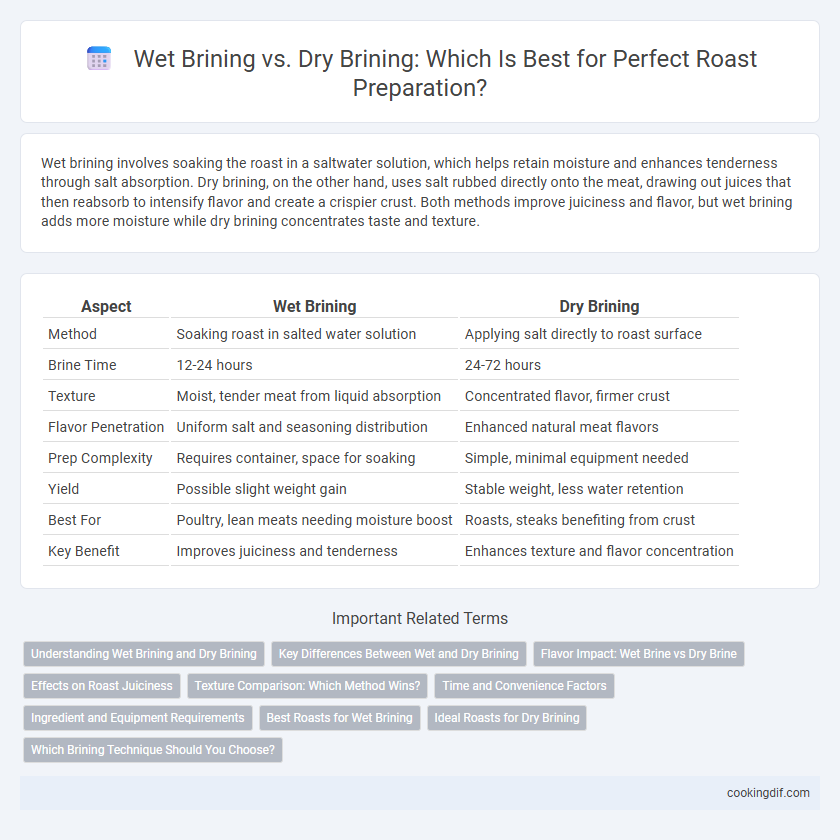Wet brining involves soaking the roast in a saltwater solution, which helps retain moisture and enhances tenderness through salt absorption. Dry brining, on the other hand, uses salt rubbed directly onto the meat, drawing out juices that then reabsorb to intensify flavor and create a crispier crust. Both methods improve juiciness and flavor, but wet brining adds more moisture while dry brining concentrates taste and texture.
Table of Comparison
| Aspect | Wet Brining | Dry Brining |
|---|---|---|
| Method | Soaking roast in salted water solution | Applying salt directly to roast surface |
| Brine Time | 12-24 hours | 24-72 hours |
| Texture | Moist, tender meat from liquid absorption | Concentrated flavor, firmer crust |
| Flavor Penetration | Uniform salt and seasoning distribution | Enhanced natural meat flavors |
| Prep Complexity | Requires container, space for soaking | Simple, minimal equipment needed |
| Yield | Possible slight weight gain | Stable weight, less water retention |
| Best For | Poultry, lean meats needing moisture boost | Roasts, steaks benefiting from crust |
| Key Benefit | Improves juiciness and tenderness | Enhances texture and flavor concentration |
Understanding Wet Brining and Dry Brining
Wet brining involves submerging the roast in a saltwater solution, which enhances moisture retention and tenderness by allowing the meat to absorb water and salt. Dry brining uses a salt rub applied directly to the roast's surface, promoting natural juice redistribution and intensifying the meat's flavor without added water. Both methods improve the roast's texture and seasoning, but wet brining generally results in juicier meat, while dry brining offers a more concentrated beef flavor and a crispier crust.
Key Differences Between Wet and Dry Brining
Wet brining involves submerging the roast in a saltwater solution, which enhances moisture retention and results in a juicier texture by allowing salt and water to penetrate the meat. Dry brining uses a salt rub applied directly to the surface, drawing out moisture that then reabsorbs, concentrating flavors and improving crust formation during roasting. Key differences include wet brining's longer preparation time and added moisture versus dry brining's simplicity, firmer texture, and intensified savory taste.
Flavor Impact: Wet Brine vs Dry Brine
Wet brining enhances roast flavor by infusing moisture and salt evenly throughout the meat, resulting in a juicier and subtly seasoned profile. Dry brining intensifies natural meat flavors by drawing out moisture and allowing salt to penetrate, creating a more concentrated and robust taste. Both methods improve tenderness, but dry brining delivers a deeper savory impact, while wet brining provides a milder, uniformly seasoned flavor.
Effects on Roast Juiciness
Wet brining enhances roast juiciness by allowing the meat to absorb water and salt, which increases moisture retention during cooking. Dry brining improves juiciness by drawing out the meat's natural juices that then reabsorb, concentrating flavor while maintaining a tender texture. Both methods optimize moisture levels, but wet brining typically results in a slightly higher overall juiciness due to added water content.
Texture Comparison: Which Method Wins?
Wet brining enhances roast texture by increasing moisture retention, resulting in a juicier and more tender final product due to saltwater solution penetrating meat fibers. Dry brining intensifies flavor while firming the meat's surface, creating a crispy crust and slightly chewier texture through salt-driven protein modification. For optimal roast texture, wet brining excels in moisture and tenderness, whereas dry brining dominates in crust formation and flavor concentration.
Time and Convenience Factors
Wet brining requires several hours to overnight soaking, allowing the meat to absorb moisture and seasoning thoroughly but demands advance planning and extra cleanup. Dry brining, involving rubbing salt directly onto the roast, is quicker to apply and frees up refrigerator space, with a typical resting time of one to two hours to overnight for optimal flavor enhancement. Choosing dry brining offers greater convenience and time efficiency without compromising the roast's juiciness and taste.
Ingredient and Equipment Requirements
Wet brining a roast requires water, kosher salt, sugar, and a large, non-reactive container such as a food-grade plastic bag or ceramic dish to submerge the meat completely. Dry brining involves only kosher salt and optionally other seasonings, with no additional container needed beyond a tray or rack to hold the roast as it rests uncovered. Wet brining demands more space and equipment for refrigeration, while dry brining simplifies preparation and reduces ingredient usage.
Best Roasts for Wet Brining
Wet brining enhances moisture retention and tenderness, making it ideal for lean cuts like turkey breast and pork loin. The saltwater solution improves juiciness and seasoning penetration, especially beneficial for roasts with less intramuscular fat. For best results, soak these roasts for 12 to 24 hours to achieve optimal flavor and texture.
Ideal Roasts for Dry Brining
Dry brining is ideal for thicker, leaner cuts like prime rib, pork loin, and turkey breast, where surface moisture control enhances crust formation and flavor concentration. The process involves coating the roast with salt and allowing it to rest, which improves tenderness by breaking down muscle proteins while retaining juicy interior moisture. Dry brining also promotes a beautifully crisp, savory crust, making it preferable for roasts cooked at high temperatures.
Which Brining Technique Should You Choose?
Wet brining enhances roast juiciness by soaking meat in a saltwater solution, allowing deeper moisture absorption and seasoning. Dry brining involves rubbing salt directly onto the meat surface, promoting better skin texture and concentrated flavor by drawing out and then reabsorbing juices. Choose wet brining for larger roasts needing extra moisture retention, while dry brining suits smaller cuts where flavor intensity and crispy crust are priorities.
Wet brining vs dry brining for roast preparation Infographic

 cookingdif.com
cookingdif.com